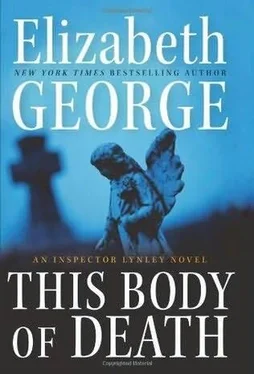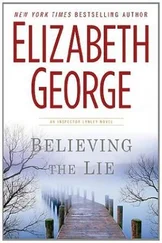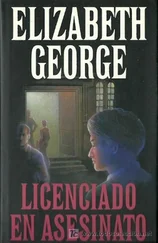She began to weep in earnest, then, and Lynley knew what her show of emotion was costing her. He said nothing else, for there was, indeed, nothing more to say.
Moments passed before she turned to him, and then it was to say, “I don’t have a damn tissue.” She began to scramble round her seat, as if looking for something. He fished out his handkerchief and handed it over. She used it, saying, “Ta. Trust you to have the linen ready.”
“The curse of my upbringing,” he told her. “It’s even ironed.”
“I noticed,” she said. “I expect you didn’t iron it, though.”
“God, no.”
“Figures. You don’t even know how.”
“Well, I admit that ironing isn’t among my talents. But I expect if I knew where the iron was kept in my house-which, thank God, I don’t-I could put it to use. On something simple like a handkerchief, mind you. Anything more complicated would completely defeat me.”
She chuckled wearily. She leaned back in the seat and shook her head. Then she seemed to examine the car itself. The Healey Elliott was a saloon with room for four, and she squirmed round for a look in the back. She noted, “This’s the first time I’ve been in your new motor.”
“The first of many, I hope, as long as you don’t smoke.”
“Wouldn’t dare. But I can’t promise I won’t eat. Nice bit of fish and chips to make the insides smell sweet. You know what I mean. What’s this then? Up for some light reading?” She fished something from the backseat and brought it to the front. It was, he saw, the copy of Hello! he’d had from Deborah St. James. Havers looked from it to him and cocked her head. “Checking up on the social scene, are you? Not what I’d expect you to do ’less you take this with you when you go for your manicures. You know. Something to read while the nails are being buffed?”
“It’s Deborah’s,” he said. “I wanted to have a look at the photos from the Portrait Gallery opening.”
“And?”
“Lots of people holding champagne glasses and looking well turned out. That’s about it.”
“Ah. Not my crowd, then?” Havers opened the magazine and began flipping through it. She found the appropriate set of pages, where the photos of the portrait competition’s opening show were spread out. “Right,” she said, “not a hoisted pint anywhere, more’s the pity. ’Cause a decent ale’s better than some thimbleful of champagne any day of the-” Her hand tightened on the magazine. She said, “Holy hell,” and she turned to him.
“What is it?” Lynley asked.
“Frazer Chaplin was there,” Havers said, “and in the picture-”
“Was he?” Then Lynley remembered how in person Frazer had seemed so familiar to him. That was it, then. He’d obviously seen the Irishman in one of the pictures of the Gallery opening, forgetting about it later. Lynley glanced at the magazine and saw that Havers was indeed indicating a photo of Frazer. He’d been the swarthy man in the picture of Sidney St. James. “More evidence he was involved with Jemima,” Lynley said, “no matter that he’s posing with Sidney.”
“No, no,” Havers said. “Frazer’s not the point. It’s her. Her.”
“Sidney?”
“Not Sidney. Her.” Havers pointed to the rest of the crowd and specifically to another woman, this one young, blond, and very attractive. Some socialite, he reckoned, the wife or daughter of a gallery sponsor, likely. But Havers disabused him of that notion when next she spoke. “It’s Gina Dickens, Inspector,” she said, and she added unnecessarily, because at that point he knew quite well who Gina Dickens was, “She lives in Hampshire, with Gordon Jossie.”
Much has been made not only of the British criminal justice system but also of the trial that followed the boys’ confessions. Words such as barbaric, Byzantine, archaic, and inhuman have been used, and commentators around the globe have taken strong positions on both sides of the matter, some of them passionately arguing that inhumanity, no matter its source, should be met with like inhumanity (invoking Hammurabi), and others of them just as passionately contending that nothing is served by the public pillorying of children and, indeed, further damage is done to them. What remains is this singular fact: Governed by a law that makes children responsible for their behaviour at the age of ten in the case of capital crimes, Michael Spargo, Reggie Arnold, and Ian Barker had to be tried as adults. Thus, they faced trial by judge and jury.
What is also worthy of note is that, when a serious crime has been committed by children, they are forbidden by law to have any therapeutic access to psychiatrists or psychologists prior to trial. While such professionals are tangentially involved in the developing proceedings against children, their examination of the accused is strictly limited to determining two things: whether the child in question was-at the time of the crime-capable of distinguishing between right and wrong and whether such child was responsible for his acts.
Six child psychiatrists and three psychologists examined the boys. Interestingly, they reached identical conclusions: Michael Spargo, Ian Barker, and Reggie Arnold were of average to above-average intelligence; they were fully cognizant of the difference between right and wrong; they were well aware of the notion of personal responsibility, despite (or perhaps because of) their attempts to blame each other for John Dresser’s torture and death.
In the climate that surrounded the investigation into John Dresser’s abduction and murder, what other conclusions could have been drawn? As has already been noted, “Blood will have blood.” Yet the sheer enormity of what was done to John Dresser begged for a disinterested approach from all parties involved in the investigation, the arrest, and the trial. Without that kind of approach in these matters, we are doomed to cling to our ignorance, believing that the torture and murder of children by children is somehow normal, when no rational mind would accept this as the case.
We do not need to forgive the crime, nor do we need to excuse it. But we do need to see the reason for it so as to prevent its ever occurring again. Yet whatever the true cause was that lay at the root of the three boys’ heinous behaviour that day, it was not presented at their trial because it did not need to be presented. The police’s function was not to delve into the psychological makeup of the boys once they were arrested. Rather, their function was to make that arrest and to organise the evidence, the witnesses’ statements, and the boys’ confessions for the prosecution. For their part, the prosecution’s function was to obtain a conviction. And because any therapeutic psychological or psychiatric attention to the boys prior to their trial was forbidden by law, whatever defence could be mounted on their behalf had to rely upon their counsels’ attempts to shift blame from one boy on to another or to chip away at what testimony and evidence the CPS presented to the jury.
In the end, of course, none of this mattered. The preponderance of evidence against the three boys made the outcome of their trial ineluctable.
Abused children carry abuse forward through time. This is the unthinkable gift that keeps on giving. Study after study underscores this conclusion, yet that salient piece of information was not part of the trial of Reggie Arnold, Michael Spargo, and Ian Barker. It could not have been, based not only on criminal law but also on the thirst (we might call it “blood thirst”) for some form of justice to be handed down. Someone had to pay for what had happened to little John Dresser. The trial established guilt beyond any doubt. It was up to the judge to determine punishment.
Unlike many more socially advanced countries in which children accused of crimes are remanded into the custody of their parents, foster parents, or some sort of care pending what is usually a hearing held in camera, child criminals in the UK are placed in “secure units” designed to house them prior to facing a court of law. During their trial, the three boys daily came and went from three separate secure units-in three armed vans that had to be protected from surging crowds waiting for them at the Royal Court of Justice-and while court was in session, they sat in the company of their individual social workers inside a dock designed especially for them and built so that they could see over the side in order to watch the proceedings. They were well behaved throughout, although occasionally restless. Reggie Arnold had been given a colouring book with which to entertain himself during tedious moments; the other boys had pads of paper and pencils. Ian Barker was stoic throughout the first week, but by the end of the second week, he continually looked around the courtroom as if seeking his mother or grandmother. Michael Spargo spoke frequently to his social worker, who often had her arm around him and who allowed him to rest his head on her shoulder. Reggie Arnold cried. Frequently, as testimony was given, members of the jury observed the accused. Sworn to do their duty, they could not have helped wondering what exactly their duty was in the situation they faced.
Читать дальше












